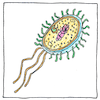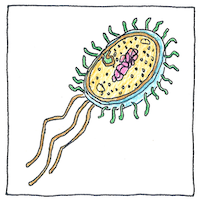Salvador Luria, Max Delbrück
genetics

|
Bacterial genes
Luria and Delbrück’s experiments showed that Darwin’s natural selection applies to bacteria. Genetic mutations giving viral resistance are selected by environmental conditions and passed to descendants. Even though bacteria have no cell nucleus as we do, their life instructions are structured the same as ours.
Bacterial statistics
The famous Luria-Delbrück experiment used statistics to make quantitative predictions about the inheritance of viral resistance in E. coli bacteria. Mutations conferring resistance occur randomly; resistance is not induced from bacterium to bacterium; nor does it occur as a response to the environment.
More of this about that
Forty million bacterial cells live in each gram of soil; a million bacterial cells live in each milliliter of fresh water. Over thirty bacterial species hitch rides in the cuticle and gut of each cockroach, with fourteen million microbes on each and seven million in each of their fecal droppings. Lest, dear reader, you start to feel superior, your own body hosts thousands of bacterial types; up to a thousand species live in your gut, and ten times more bacteria than human cells live in your body.



The scientists who contributed to the development of the atom bomb worked with and helped Luria and Delbrück.
Enrico Fermi helped Luria get established in the United States. Luria was James Watson’s Ph.D. advisor. (Watson and Francis Crick discovered the DNA structure of the genetic code.)
Wolfgang Pauli and Niels Bohr got Delbrück interested in biology. Delbrück became Lise Meitner’s assistant. (Otto Robert Frisch was Meitner’s nephew.)
See also in The book of science:
Readings in wikipedia: